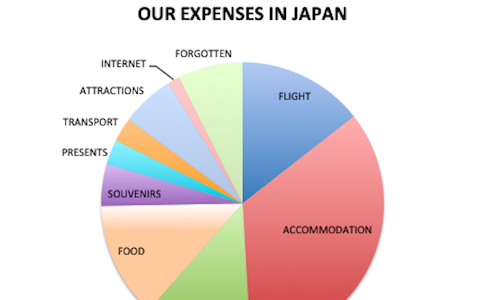Our honeymoon to Japan was one of the best trips we ever did. In this post, we detail our travel budget for our honeymoon to Japan: we hope to help you see that it is possible to travel to Japan on a tight budget, and also to make it a luxury experience.
Since this was a unique occasion, we treated ourselves to some special experiences, but we were still mindful of many other aspects in order to try and save money. Find our full itinerary here, with detailed attractions and activities in each city we visited: Tokyo, the Nagano area, Osaka, Kobe, Kyoto, Nara, Hanoke, and back to Kyoto.
Also, it’s important to note that most of our guests gifted the honeymoon to us. We asked them to wire their present to our multi-currency Wise account, so we were ready to exchange it for yen! It was brilliant and super convenient – and, again, a simple way to save some money.
Help me run my blog! This post contains some affiliate links: the small commission I may earn if you click through and make a purchase/booking (at no extra cost to you) will go towards supporting the site and our travels. That means more posts and useful info for you!
We only recommend products we use ourselves and believe in. Thank you for supporting Travelling Sunglasses!
Click here to read our full disclosure.
Total cost for 2 weeks in Japan
Let’s get straight to it: the cost of our 2-week honeymoon in Japan in October 2018 was approximately 5300 EUR, for the two of us, including everything: flight, accommodation, transport, food, attractions, souvenirs, presents, pocket WiFi, and a new backpack (minus that, the total would be 5150 EUR).
In general, we are mid-range-budget travellers: even though we (actually Darek) have a reasonably good salary in Hungary, the currency is not strong and costs are high everywhere we go. Consequently, we try to save when we can, not waste money on meaningless stuff, and splurge when the occasion is right.
We already owned Darek’s backpack and the camera gear.
I calculated the total cost of our Japan honeymoon with our bank statements and cash exchange receipts, but unfortunately I didn’t keep track of the expenses while travelling too well: I only noted 4900 EUR 😀
Also, here I am not keeping into account banking fees and cash exchange commissions, which could be approx 50 EUR. Exchange rates could also cause minor discrepancies: we spent Euros (1 EUR = 130 yen), Hungarian Forints (1 EUR = 320 Forints) and Yen.
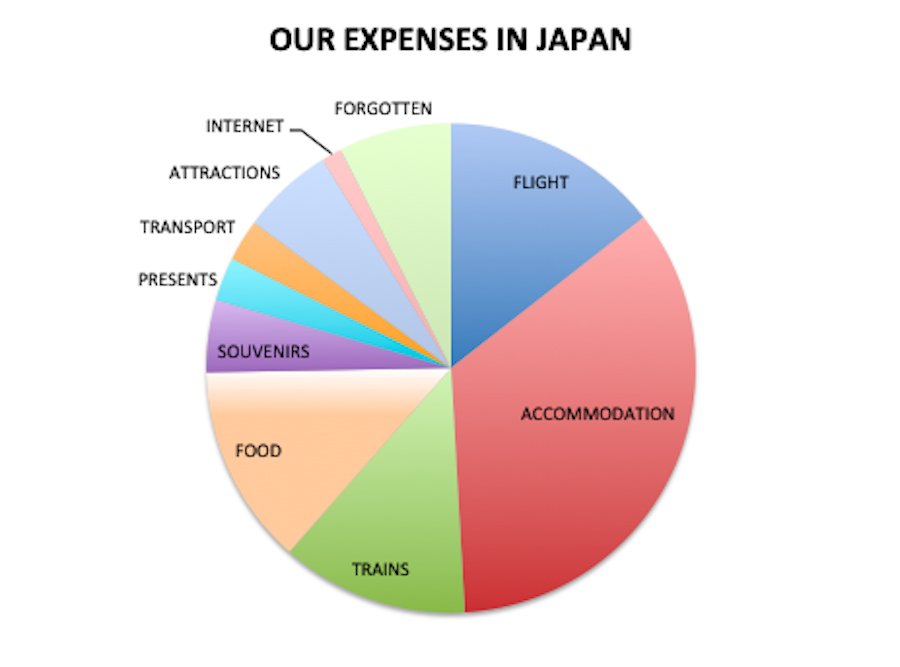
Flight to Japan
How much was our flight to Japan? We travelled from Budapest to Tokyo in late October 2018 with LOT (Polish airline) and we spent approx. 750 EUR for a return ticket for both of us, which is 375 EUR each. We booked in March 2018, fairly in advance.
We definitely saved some money on luggage. We carried hand luggage only! Backpacking helped us: lower flight costs, fewer complications on internal transport, and motivation to buy lighter souvenirs (because they weigh on your shoulders!).
We chose this flight after researching on Skyscanner; cheaper options were available, but with much longer layovers. This flight instead had just a 1-hour layover in Warsaw, both ways.
Accommodation in Japan for a honeymoon
For 14 nights in Japan, we spent 1780 EUR, on average 127 EUR per night for both of us, which is quite normal in Japan.
We booked just a month in advance, perhaps prices would have been lower earlier. We tried many different types of accommodation, but with some common features: always private double rooms, in a clever location, with a somewhat nice or authentic design whenever we could, and balancing some expensive ones with cheap ones. We tried to stay within a reasonable honeymoon budget and we did a good job!
Here are the links, so you can book them too! We booked the Ryokan directly, and the rest we booked on Booking.com. It was very convenient to rely on Booking.com (for language, prices, address, research) so we recommend it.
We spent 3 nights in expensive Ryokan, the traditional Japanese accommodation which includes a unique tasting dinner, breakfast, and onsen access:
– Hishiya Torazo in Shibu Onsen cost 250 EUR, a gorgeous, traditional Ryokan with a memorable natural onsen
– Yudanaka Seifuso Onsen in Yudanaka 170 EUR, another excellent place with a great meal
– Edosan in Nara 340 EUR, where we had the most memorable experience of dinner served in our room.
For one night each, on average 253 EUR each. The more expensive ones were more special 🙂
We spent 5 nights in Western-style hotels, in Osaka, Kobe and by Narita airport:
– In Osaka at Candeo Hotels Osaka Namba we spent 110 EUR/night without breakfast (but with rooftop spa, I still dream of that modern cozy and luxurious spa!)
– in Kobe at Hotel Trusty 183 EUR with breakfast – it was nothing special, I’d rather recommend the Kobe Luminous Hotel Sannomiya or the Brenza Hotel) that seem more inviting
– and at Narita airport at Narita View Hotel (now called Art Hotel Narita) 87 EUR with breakfast and spa, a great spot if your flight is very early the following morning.
In those cities there wasn’t much choice of guesthouses or hostels with private rooms, but truly, we enjoyed the comfortable beds and private rooms (sooo small rooms, unbelievable, but all hotels have small rooms).
We spent 2 nights in capsule hostels:
– in Hakone at Azito Guesthouse we spent 60 EUR, a very nice and friendly hostel
– in Tokyo at Book and Bed Shinjuku we spent 75 EUR such a cool hostel with a spacious and cozy reading area where you can take books off the shelves and relax.
Both were without breakfast, with shared bathrooms and showers, and the capsule was reasonably spacious. Not a coffin feeling. We liked the experience!
We spent 3 nights in a traditional guesthouse in Kyoto, Uronza Guesthouse for 60 EUR/night without breakfast and with shared bathrooms and showers. One morning, we had the tea ceremony for just 1000 YEN, 7.80 EUR each! Staying in a historical Japanese building, registered as a cultural property of Japan, really felt like travelling in time.
We spent 1 night in a hotel in Tokyo, Hotel Fukudaya, a mixture of old style (tatami floor) and modern (tiny ensuite bathroom), without breakfast but close to Shibuya, at 93 EUR.
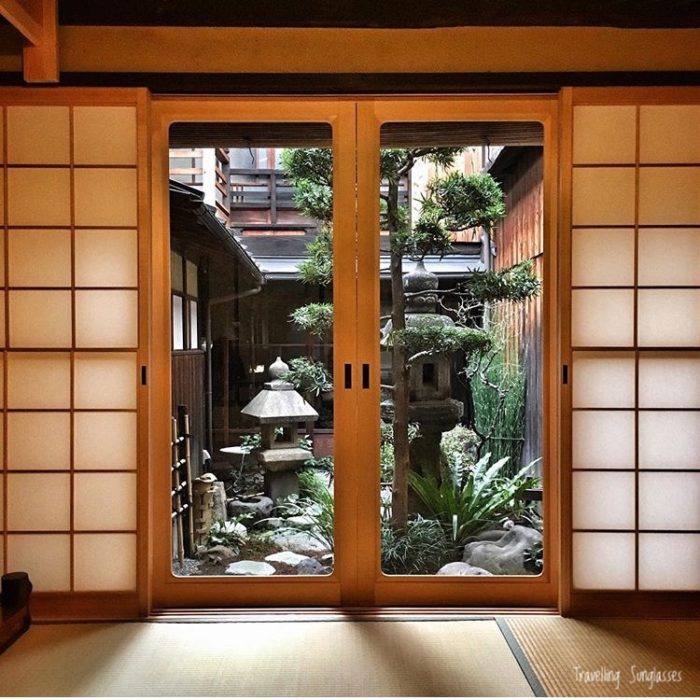
Trains in Japan
A good chunk of our Japan honeymoon travel budget was taken by train tickets. We spent 316 EUR per person on long-distance trains, or trains between cities.
The most expensive tickets were, of course, the Shinkansen bullet trains from Tokyo to Nagano (60 EUR each), the one from Nagano to Osaka (90 EUR each) and from Kyoto to Odawara (88 EUR each). Cheaper options were available, but they took longer. Time was more important for us.
All other trains were very affordable, clean and frequent, with 5-10 EUR each for trips of 1-2 hours between Osaka, Kobe, Nara and Kyoto.
We did not buy the JR pass (Japan Railways), because we knew it was not possible to use it on all trains. As it turns out, there are so many railway companies and sometimes JR is not the most convenient one, so we were happy to not be bound to them.
TRAVEL TIP: The best website to plan your trip is Hyperdia, but sometimes Google Maps is much more convenient and practical. It even shows the prices!
BONUS TRAVEL TIP: the turnstile will keep your precious tickets on the way out of the station! If you wish to keep it, ask someone of the staff, they will stamp it and let you out 🙂
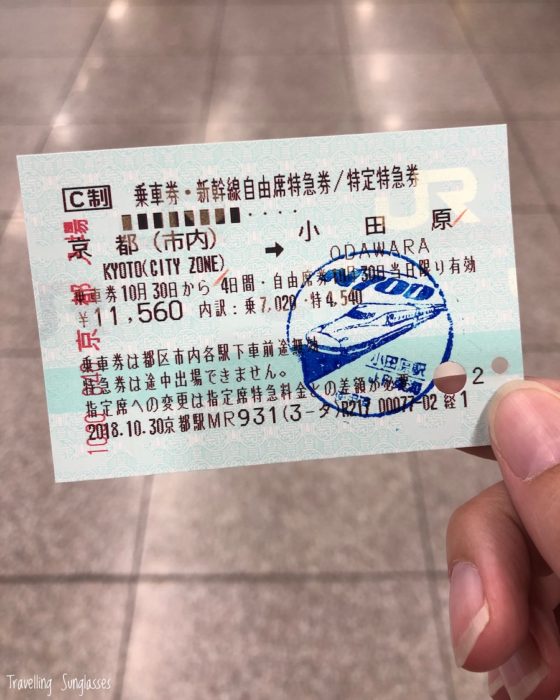
Food during a Japan honeymoon
We wanted to try lots of Japanese food during our honeymoon! We spent 680 EUR in total for both of us for 14 days of travel (the 3 ryokan dinners and breakfasts are not included here, they count as accommodation), which means on average 24-25 EUR per person per day.
Keep in mind that we don’t each much. To be more specific:
We spent 4,65 EUR for each of us for breakfast, when not included in the accommodation. Sometimes coffee and cake at a café (7-8 EUR), sometimes take-away coffee and a croissant at a bakery or supermarket (2-3 EUR).
We spent 4,20 EUR each for lunch everyday, but sometimes we replaced it with coffee or a snack. Noodles or dumplings in a “restaurant” could cost approx. 10 EUR; a bowl of rice and meat in a fast-food chain like Matsuya or Sukiya 4 or 5 EUR. Sometimes we had a big breakfast, so a couple of onigiri rice balls for 2 EUR was enough! The most expensive was lunch in the Wizarding World of Harry Potter at Universal Studios Osaka: 18 EUR for a plate of (small) pork ribs, veggies and potatoes, and a bottle of water. I was feeling dizzy so we shared one plate. Butterbeer was so sugary it could count as lunch!
We spent 15,30 EUR each for dinner, when not included in the accommodation. In general, we indulged more on dinner than on lunch, but still kept a balance: a fast-food rice bowl or ramen for 4-5 EUR each, a nicer dish of noodles or gyoza dumplings for 10 EUR each, tempura and sake for 20 EUR each. Darek’s birthday dinner was 30 EUR each, for three batches of whiskey tasting and a portion of delicious beef cutlets. Our epic Kobe beef dinner at Steakland in Kobe was only 45 EUR each, check out our mouthwatering video!
We were always exhausted at night and did not go out much, so we spent only 66 EUR on drinks during the whole holiday, on 4 occasions. That’s 8,24 EUR per person per occasion: sake at a Ryokan, drinks at the hostel in Hakone, beer with new friends in Tokyo, and whiskey on our last night at Golden Gai in Tokyo (some of those bar charge an extra just to let you sit there and have a drink, keep it in mind! We liked the spot so we accepted it.)
Finally, we spent on average 2,65 EUR each per day on snacks like coffee (2-4 EUR), takoyaki octopus balls (7,80 EUR for one portion with a beer, we shared it), Taiyaki cakes (delicious at 1,50 EUR each), onigiri (less than 1 EUR each)… The most expensive was Butterbeer at the Wizarding World of Harry Potter, 5 EUR for a glass!
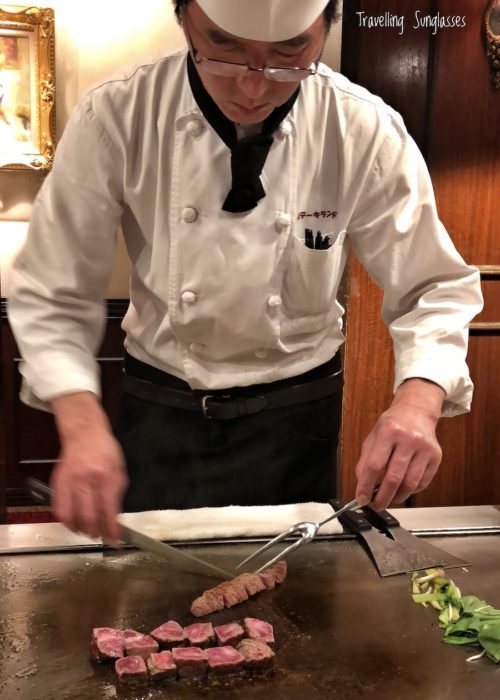
Local transport in Japan
Local transport in Japan doesn’t feel like a big expense, but it adds up in the final budget. We spent on average 5,25 EUR each daily on transportation within the same city (metro, bus etc), 140 EUR in total.
An average metro/bus ticket for 1 trip in Osaka, Kyoto or Tokyo cost between 1 and 2 EUR, up to 4 if you cross the whole town.
Special mention to the Hakone free pass, which is not free at all but is still convenient: for 30 EUR each (from Odawara), we could use all means of transport in the Hakone area for 2 days. If we bought each ticket separately, and it would have been more expensive. We took a bus, a pirate ship, a ropeway, a steep train (they call it cablecar), another train (3 times in 2 days), so we could say 30 EUR/8 trips = 3,75 EUR per trip. Hakone was one of our favourite stops in this trip, check out our video!
Special experiences during a honeymoon in Japan
While planning our itinerary, there was something special to do everywhere we went! A honeymoon is a special trip, so a honeymoon travel budget should make space for these experiences!
We spent 310 EUR in total, approximately 11 EUR each daily on attractions and experiences, including: temples, castles, lockers of said attractions, Universal Studios, tea ceremony, museums, beer on the Asahi Sky Terrace, ferris wheel…
Worth mentioning:
The Monkey Park at Shibu Onsen was 6,15 EUR each. The park is beautiful and the monkeys were adorable.
The tea ceremony at our accommodation Uronza guesthouse was 7,80 EUR each. We watched and then served tea to each other, just the two of us. It was hilarious 🙂 Check out here more unique Japan experiences.
Hakone Open-Air museum was “expensive” with 12,30 EUR each, but the modern art was gorgeous and really worth it.
Mori Digital Art museum in Tokyo was “really expensive” with 25 EUR each, but so entertaining and surprising, absolutely worth it.
Universal Studios in Osaka was “ridiculously expensive” with 60 EUR each, but so fantastic and exciting and marvellous and amazing that I would go back right now. Luckily in October we did not need any more passes to save time or skip the queues.
A few temples and shrines charge 2-4 EUR tickets, e.g. Kofukuji and Todaiji in Nara, and Kinkakuji (the Golden Pavilion) in Kyoto. They were all worth it.
TRAVEL TIP: the Asahi building, close to Sensoji temple, is shaped like a beer mug! As if this wasn’t clever enough, access to the Sky Room on top of it is free of charge, and a beer cost approx 5 EUR. Perfect for sunset!
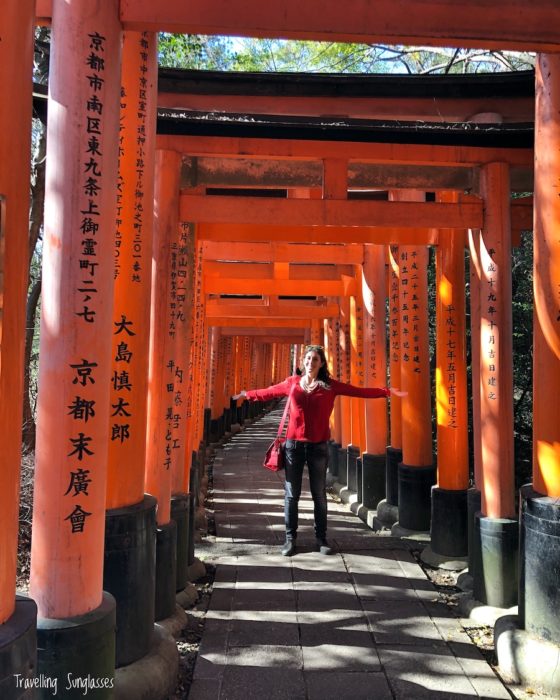
Iconic souvenirs from Japan
We spent 245 EUR on souvenirs, which is approx 8.75 per souvenir. Postcards, a bracelet, biscuits for Nara deers, books, small home decor, wooden shot glasses, a daruma doll, a poem by the Empress… But most importantly:
The Red Stamp Book “Goshuincho”: in every temple you can get its specific stamp with Japanese calligraphy. These stamps are supposed to be collected in a booklet called Goshuincho, which can be bought at most temples. It’s a heritage from ancient times, when pilgrims would travel from temple to temple and have proof of their pilgrimage. The booklet cost 8 EUR and each stamp 2,30 EUR, we got 11 stamps. A fantastic souvenir! Read more here.
A wand from the Wizarding World of Harry Potter: I could not resist. The “magical” version allows you to perform magic on some spots of Hogsmeade! It cost 37 EUR.
Yukatas: they are the summer version of kimonos, or a simplified version if you wish. We bought ours in Kyoto at Chicago for approx 50 EUR each (not sure if they are second-hand or not).
Beautiful things we got for free: origami from the ryokan owner in Shibu Onsen and from a gentleman on the way to Yudanaka.
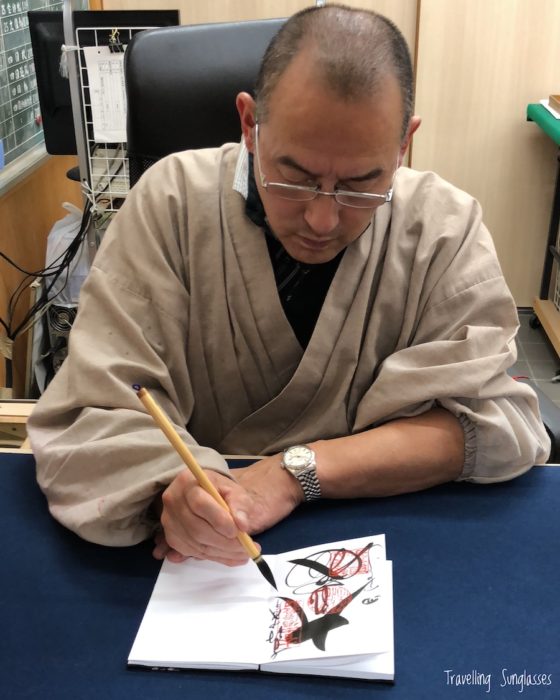
Simple, authentic presents from Japan
We spent 150 EUR on presents for our most loved and close ones. Authentic souvenirs could be daruma dolls that help you achieve a goal or a wish (available in lots of sizes and prices, ours were small 2 EUR ones), or temple charms for health, luck, love (from as little as 2 EUR to more than 10). Our small backpacks allowed only small souvenirs 🙂
Japan Pocket Wi-Fi
We ordered our pocket wifi with Japan Wireless. We spent 70 EUR for those 14 days, including delivery to Narita airport, insurance, a power bank, cable and plug.
We were really satisfied: a small device that fits in one hand provided unlimited WiFi everyday, with a battery life of 8 hours! We turned it off while visiting places, turned it back on when looking for our next destination on Google Maps, and charge it in the evening. At night, sometimes it was more stable than Hotel WiFi for uploading videos and pictures. We had only one converter, so the plug turned out to be super useful, because we could plug any USB cable to it.
These services and apps made my trip to Japan much easier and enjoyable! Check them out:
- The Wise Multicurrency Card where I could exchange money into yen with 3 taps on my phone, and save on unexpected bank fees
- Booking.com and its clear layout made it easy to choose and manage our accommodations
- Google Maps, full of attractions saved and very useful for the local public transport
- OneNote where I had all my plans and notes of where to go and what to do
- Snapseed for easy and quick photo editing
- And most of all, Japan Wireless, because we always needed an internet connection to make it all work! We used the handy Pocket Wifi, and next time we’ll try the magical eSIM.
Backpacking in Japan
Travel light, travel often! We challenged ourselves to travel with just a small backpack as hand luggage, meaning less than 8 kg. I’m proud to say we succeeded, check out our video!
For the occasion, I bought my first proper backpack, inspired by Darek’s excellent Osprey backpack. I chose an Osprey Transporter 40-litres, which fits in the usual hand luggage sizes of approx 50x35x30 cm. We packed only the strictly necessary, planned to wash socks and underwear, and counted with empty space to be filled with souvenirs 🙂
We were very satisfied with this choice: it was so practical to get on and off trains, move around the city (and we changed many, see our itinerary), avoid fees to move big suitcases between cities, and save money on the flight tickets. The backpack and a quick-dry large towel cost 150 EUR, and it was a great expense in this honeymoon budget – I still use it on most trips we go on.
Keeping track of expenses on OneNote
While travelling, I was taking notes of all expenses and transactions on OneNote, a free Microsoft software.
I tracked expenses and money exchanges on different pages:
Expenses on one page, e.g.
30 OCTOBER:
23120 Shinkansen to Odawara x2 Wise
990 breakfast in Kyoto
1040 coffee and cakes in Odawara
8000 Hakone free pass x2 Wise
5100 souvenirs
500 black egg
2350 dinner
7800 Azito Guesthouse
2500 drinks
Money exchanges on another page, e.g. Forints to Yen here in Budapest, Euro to Yen on the multi-currency Wise debit card (formerly TransferWise Borderless card), Euro to Yen cash in Japan, and cash withdrawals.
This is how I ended up knowing exactly how much money we changed into Yen and spent, but not exactly how because I forgot to note some of the expenses 🙂
How to pay in Japan: Wise card, cash and normal cards
We were scared that our cards would not work in Japan, or that some places may not accept them (and truly some places do not), so we prepared cash and two cards: we exchanged cash for Yen in Budapest before departure and brought Euros in cash; we exchanged Euros to Yen inside our Wise debit card; and we were able to withdraw yen from the Wise card and from Darek’s Hungarian Mastercard.
Wise (formerly TransferWise) was a great asset during the trip (read more on our review here). It’s so clever and easy: the card can hold many different currencies, which you can exchange within seconds on the app on your phone. They always use the official exchange rate of the day (the one you find on Google) and show you the fee they will charge. No crazy surprises on your bank report at the end of the month!
This is how Wise works: first, you transfer some money to your Wise account (either from your own bank account to the IBAN (bank account number) connected to the card, or you can “pay” with your normal card on the Wise app, and receive the money on your Wise account). Second, you can open a new currency on the Wise website or app: the card is like a wallet with many pockets that can hold different currencies, and you open whichever pocket you need. Finally, you choose how much money to exchange, and wow! You have a card with your normal currency and Yen. We paid for all hotels with the Yen on the card, exchanged at the best rate possible. The other currencies were separated and stay where they are. What if you finish the Yen? We did it, and it still worked! A hotel used the last few yen remaining, and then the card automatically exchanged the needed amount from Euro to Yen, at the best exchange rate. The app is so easy to use, I was truly impressed. We highly recommend it! Click here to create your account and request your Wise debit card, and I may receive a small commission. Thank you!
TRAVEL TIP: Carry Yen in cash with you at all times. Yen banknotes and coins are used frequently, especially at vending machines and small restaurants/shops/onsens. You might order your lunch at the vending machine by the door of a restaurant, or pay the entrance to an onsen at a vending machine.
Forgotten expenses
I did not keep track of expenses for 386 EUR, which is 13,80 EUR per person per day.
Plan your perfect trip to Japan with my detailed and inspiring posts:
- 2-week honeymoon itinerary in Japan, our full guide with maps and details
- How much we spent on our honeymoon to Japan
- Useful and practical travel tips to plan your trip to Japan
- 5 unique Japanese experiences you have to try
- The most unique Japanese souvenir: the Goshuincho book
Final thoughts on the travel budget for our honeymoon to Japan
So, to summarize: on our honeymoon in Japan, we spent on average 156,77 EUR/day each, excluding flight and new backpack, including the forgotten expenses.
We spent on average 70,69 EUR/day each, excluding also accommodation and train, so just food, attractions, transport, souvenirs, presents, and the forgotten expenses.
Overall, it was a fabulous honeymoon and an absolutely memorable trip! Yes, it was a bit expensive, but I’d do it again in a heartbeat.
What we noticed was that, by choosing cheap accommodation, food and trains, Japan can be an affordable country to visit. It is definitely possible to plan a similar Japan honeymoon and spend less (but also more!)
Are you considering visiting Japan? Let us know in the comments 🙂 cheers!
